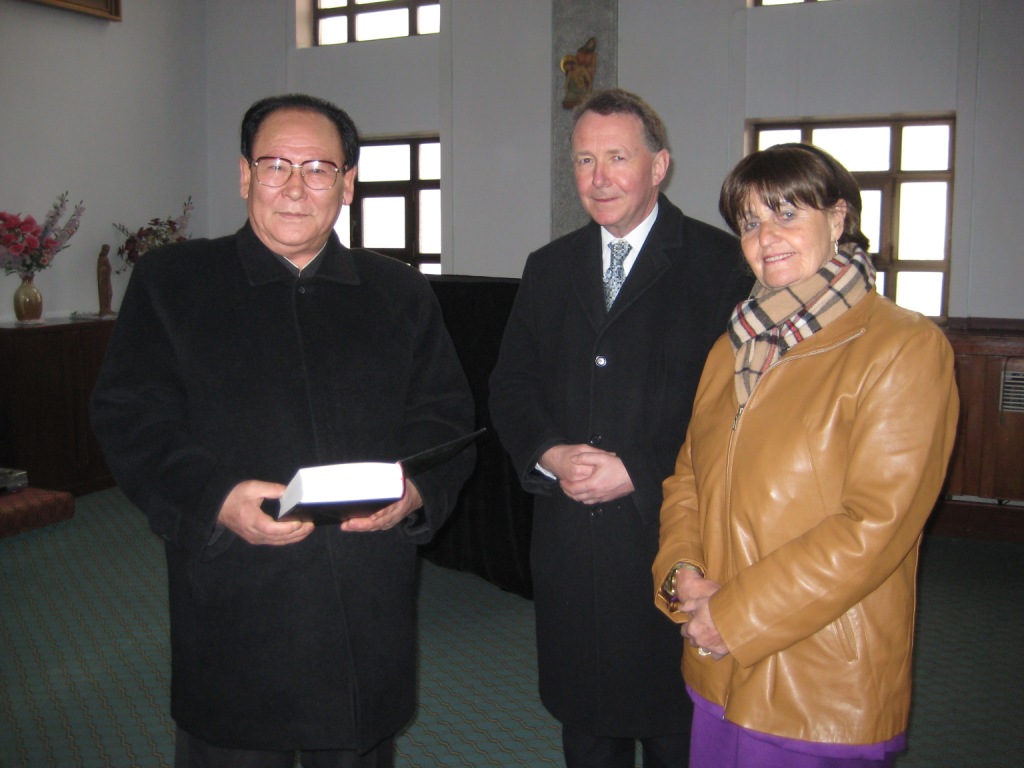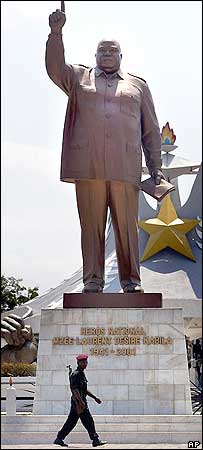By Michael Rank
Link to full report by Lord David Alton and Baroness Caroline Cox at the bottom of this story
|

|
Above: Alton and Cox present a Bible to Jang Che On, chairman of the Korean Consultative Society of Religious Believers
|
A British politician who visited North Korea this month to investigate the country’s human rights record and promote dialogue said she had been pleasantly surprised to come across an active Protestant seminary in Pyongyang with about 10 students and a church with a Bible on every pew.
Baroness Caroline Cox, who visited Pyongyang as vice chairman of the All Party Parliamentary Group for North Korea, also urged the United States to end hostilities with North Korea and open an embassy in Pyongyang, just as Britain did 10 years ago.
Cox, a devout Christian, said she was sure the congregation at the Protestant Pongsu church included many genuine worshippers as well as some officials and informers, and that the church was not simply a propaganda showcase for the regime.
She told NKEW that the church was “surprisingly big” and that the attached seminary had been opened with South Korean support and that South Koreans had apparently provided the Bibles. She was told that about 300 people regularly attend Sunday services.
She said she that although “there is a show element in it”, she did not believe the seminary could be written off simply as an empty showcase, as she had to push quite hard to visit it and some officials did not seem aware of its existence.
Cox said Choe Thae Bok, chairman of the Supreme People’s Assembly, repeated an official invitation to the Archbishop of Canterbury, Dr Rowan Williams, to visit the DPRK. Choe met Williams when he visited London in 2004.
Cox and the Parliamentary Group’s chairman, Lord Alton, a fervent Catholic, also visited the recently opened Russian Orthodox church which she described as “extremely beautiful” and where they met two North Korean priests, Fathers Thaddeus and Theodore. She said the Moscow-trained Father Thaddeus was particularly warm and open, but she added that the congregation appeared to consist entirely of Russian diplomats and business people rather than North Koreans.
The delegation also, somewhat surprisingly perhaps, called for senior North Korean military officials to be invited to visit Sandhurst, Britain’s premier military academy.
Cox said their visit, their second to Pyongyang, was aimed at building “bridges not walls” and that she believed there are “people [in North Korea] who genuinely want to dig themselves out of the hole they have been dug into by the Great Leader.” She and Alton first visited North Korea in 2003.
The two said in a statement that they were were “less than encouraged by our visit to Changchung Catholic Cathedral and our meeting with Mr Jang Jae On, Chairman of the Korean Consultative Society of Religious Believers.
“The delegation expressed their dismay at the continued failure to provide a resident Catholic priest and the lack of progress in normalising relations with the Holy See.
“The delegation emphasised to Mr Jang that if the DPRK wishes to send a positive message about its respect for religious freedom, as enshrined in its Constitution, it would address these two fundamental issues.
“Concerns were also raised about why the importing of Bibles should remain a serious offence, which has been treated in some cases as a capital offence. The delegation gave Korean Bibles to their hosts as a sign of respect and we hope these were received in the spirit in which they were given.”
On the political side, the group’s recommendations include:
1. “a call to the incoming Administration of President Barack Obama to instigate a formal cessation of hostilities and normalisation of relations with the Democratic Peoples republic of North Korea (DPRK). The United Kingdom established a diplomatic mission in the Pyongyang ten years ago; this would be an opportune moment for the United States to do the same.
2. “a recognition of the error of not linking human rights and security concerns in the six-party talks – constructive critical engagement with Pyongyang is recommended: a ‘Helsinki Process with a Korean Face.’
“a call for renewed concerted international pressure to grant access to Professor Vitit Muntarbhorn – the United Nations Special Rapporteur on Human Rights, access to the DPRK. He has estimated that 400,000 people have died in the camps in the last 30 years.
3. “encouragement of the DPRK to allow greater freedom of information for its citizens and access for aid agencies to carry out their work – in particular in the areas of capacity building and health care.
Their principal findings include:
1. deep concerns over human rights, humanitarian and security issues – issues they raised during high level meetings with DPRK government ministers and officials.
2. the consequences of deteriorating relations between North and South Korea which could jeopardise a historic opportunity for progress.
3. observations about political and religious liberties, including some positive developments which were noted and appreciated.
Their full report can be read at the London/Korea Links web page.


